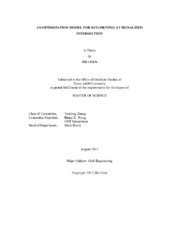| dc.description.abstract | This research develops an optimization model for eco-driving at signalized intersection. In urban areas, signalized intersections are the “hot spots” of air emissions and have significant negative environmental and health impacts. Eco-driving is a strategy which aims to reduce exclusive fuel consumption and emissions by modifying or optimizing drivers’ behaviors. With the help of vehicle-to-vehicle (V2V) communication and vehicle-to-infrastructure communication (V2I), eco-driving could utilize the signal phase and the queue-discharging time information to optimize the speed trajectories for the vehicles approaching an intersection in order to reduce fuel consumption and emissions. A few research studies have been conducted on the development of algorithms that utilize traffic signal information to reduce fuel consumption and emissions.
Hence, the goal of this research is to develop an optimization model to determine the optimal eco-driving trajectory (the speed profile) at a signalized intersection, which aims to achieve the minimization of a linear combination of emissions and travel time. Then enumeration method, simplex optimization and genetic algorithm are investigated to determine a practicable and efficient method to solve the proposed optimization problem. As various scenarios of distance from the vehicle to the intersection, queue discharging time and weights of emission/travel time will lead to different optimal trajectories and different emissions and travel times. A sensitivity study is conducted to analyze and compare the performance of the optimal solution in various scenarios of different such parameters. In addition, a baseline study is conducted to investigate the benefits of eco-driving when drivers only decelerate in advance but not apply the recommended speed trajectory. The results of case study show that genetic algorithm is a preferred method to solve the proposed optimization problem; Eco-driving could achieve satisfied reduction in emissions without significantly increasing travel time and emissions is more sensitive to various scenarios than travel time; Eco-driving still could achieve reduction in emissions as long as the drivers decelerate earlier even though the they would not apply the recommended speed trajectory under certain conditions. | en |


